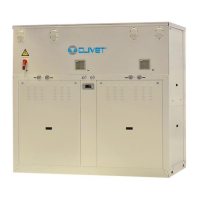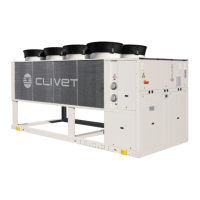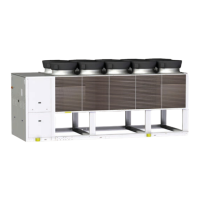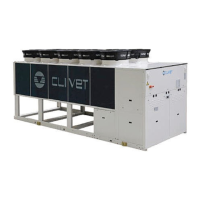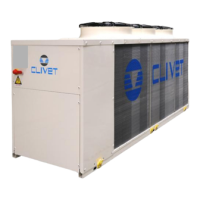Do you have a question about the CLIVET XSC 115D and is the answer not in the manual?
Provides instructions for unit installation, use, and maintenance.
Covers preliminaries, safety precautions, and handling of packing materials.
Explains safe unit operation and actions to take during breakdowns.
Details verification of electrical line characteristics and safe placement requirements.
Explains the serial number label for unit identification and spare parts.
Discusses the importance and placement of antivibration devices for unit support.
Emphasizes operating in compliance with safety regulations for detailed information.
Outlines checks for damage, correspondence, and anomaly reporting procedures.
Advises to observe external packaging instructions.
Details verifying unit weight, lifting capacity, and critical handling points.
Stresses careful removal to avoid unit damage and proper disposal.
Advises operating per safety regulations and considering installation elements.
Explains the purpose of functional clearances for operation, maintenance, and safety.
Details indoor installation criteria, vibration limits, and access requirements.
Describes the function of the external probe for automatic set-point adjustment.
States that selection and installation must be done by the installer following regulations.
Lists and describes essential components like cut-off valves, thermometers, and expansion tanks.
Provides a step-by-step guide for system operation, including leakage tests and filling.
Details factors affecting water quality and their consequences, advising avoidance of certain elements.
Advises adopting measures to prevent freezing, especially for water connections.
Recommends using inhibited glycol solutions and checking compatibility.
Explains the procedure for making Victaulic connections, emphasizing care.
Illustrates recommended connection diagrams for the use side of the system.
Shows the recommended connection schema for the source side of the system.
Details the optional recovery exchanger and its management, including safety precautions.
Illustrates the water connection diagram for units in cooling-only mode.
Shows the water connection diagram for units configured as heat pumps.
Depicts the water connection diagram for units with a reversal on the water circuit.
Details the Hydropack accessory options for different pump configurations and their benefits.
Explains the assembling and connection of pressostatic valves, performed by the customer.
Stresses that electrical line characteristics must be determined by specialized personnel per regulations.
Explains where to find unit-specific electrical data and how it's reported on the serial number label.
Provides steps for making electrical connections, including earthing and cable fixing.
Gives guidance on laying cables, avoiding interference, and respecting signal parameters.
Illustrates the inlet points for electric lines and general connection practices.
Details specific connections to be performed by the customer, referencing diagrams.
Explains the function and application of various electrical components and terminals.
Describes how to use remote controls for unit operation, set-point changes, and mode selection.
Explains the functionality and configuration of demand limit and water reset inputs.
Details various communication gateways (Modbus, BACnet, LonWorks) and their requirements.
Lists essential checks to perform before starting up the unit, covering power, safety, and integrity.
Outlines the operations required to start up the unit after preliminary checks are completed.
States that operations should be performed by qualified technicians and agreements made with service centers.
Lists items to verify before starting, including unit installation and power supply sectioning.
Details checks for refrigerant circuit integrity, pressure, and service outlet status.
Explains procedures for connecting the hydraulic system, including cleaning, filling, and air evacuation.
Covers verifying ground connection, conductor tightening, voltage, frequency, and phase balance.
Advises connecting and checking compressor crankcase resistances before starting.
Details checks for operating temperatures, supply voltage, and total unit absorption.
Describes checking the connection and enabling of remote controls and optional components.
Warns against prolonged operation at reduced load due to potential compressor damage and warranty voiding.
Explains the importance of identifying operating conditions for long-term unit control and data availability.
Refers to the directive for installers and users, including compulsory verifications and certifications.
Explains how to limit absorbed electric power using an external signal and parameter configuration.
Describes the automatic set-point correction based on an external signal and its working process.
Details automatic set-point correction based on external air temperature and its parameter configuration.
Explains automatic set-point correction based on external air enthalpy for winter operation.
Details the functions of the control interface buttons (F1-F4, ESC, HOME) and display elements.
Explains how to turn the unit on/off using the switch and checking conditions remotely.
Clarifies the priority of remote control (SA1) over keypad or supervisor control.
Describes how the thermoregulation is performed based on the supply temperature and a project thermal jump.
Guides users on navigating the setup menu for parameters, scheduling, clock, and password.
Explains how to identify, reset, and manage alarms, distinguishing between pre-alarms and faults.
Provides a list of alarm codes associated with different electronic modules and explains the alarm structure.
Details how to access and view system status information for different unit modules via the STATA menu.
Lists and defines general and compressor module status parameters, including unit status, mode, temperatures, and valve states.
Emphasizes that maintenance must be done by authorized centers or qualified personnel to maintain efficiency.
Specifies the recommended frequency for inspections, depending on unit type and usage.
Advises creating a unit booklet to record interventions for troubleshooting assistance.
Provides instructions for periods of inactivity, including power disconnection and frost risk avoidance.
Advises checking the water filter to ensure it does not impede water passage.
Highlights the importance of clean exchanger surfaces and checking temperature differences for cleaning.
Details checks for circulation pumps, including leaks, bearing status, and terminal covers.
Lists comprehensive checks for the control board, including structure, water circuit, electrical circuit, refrigerant circuit, and control system.
Lists potential causes and solutions for common alarms related to high pressure, low pressure, probes, transducers, and compressor protection.
Instructs on safely disconnecting the unit, recovering fluids, and avoiding environmental leaks.
Emphasizes sending the unit to authorized centers for dismantling and disposal, recovering materials responsibly.
Explains compliance with WEEE directive for environmental protection and proper disposal of electrical equipment.
Highlights general risks and precautions, including wearing protective clothing and avoiding unqualified personnel.
Warns about the danger zone, handling hazards, and the importance of following instructions.
Covers risks associated with incorrect installation, site selection, and general operational anomalies.
Details hazards related to electric parts, earthing, and moving components like fans.
Addresses risks from refrigerant expulsion, contact with heat sources, and hydraulic leaks or projections.
Provides detailed dimensions, weights, and specifications for WSH-XSC 65D to 80D models.
Presents detailed dimensions, weights, and specifications for WSH-XSC 85D to 120D models.
Lists detailed dimensions, weights, and specifications for WSH-XSC 135E to 180F models.
Provides additional dimensional details and specifications for WSH-XSC 65D to 80D models.
Offers extended dimensional details and specifications for WSH-XSC 85D to 120D models.
Presents extended dimensional details and specifications for WSH-XSC 135E to 180F models.
Details cooling capacity, compressor power, total power, and EER/ESEER for various models.
Provides heating capacity, compressor power, total power, and COP for various models.
Lists compressor types, number, rated power, oil charge, and control steps.
Specifies internal exchanger type, water flow rates, and pressure drops.
Details external exchanger type, water flow rates, and pressure drops.
Covers water fitting sizes and standard power supply voltage and frequency.
Presents full load current, power input, and maximum inrush current for different models.
Lists maximum water inlet and minimum outlet temperatures for the external exchanger.
Provides maximum water inlet and minimum outlet temperatures for the internal exchanger.
Details sound power and pressure levels for different octave bands and configurations.
Illustrates pressure load vs. flow rate for the evaporator across different models and configurations.
Shows pressure drop vs. flow rate for the condenser across different models and configurations.
Depicts the pressure drop caused by the water filter accessory for various unit sizes.
Presents graphs showing pressure drop for partial and total energy recovery systems.
Lists correction factors for internal and external exchangers based on ethylene glycol concentration.
Provides fouling correction factors and operating limits for internal and external exchangers.
Details calibration settings for overload and control devices like pressure switches and safety valves.
Provides instructions for unit installation, use, and maintenance.
Covers preliminaries, safety precautions, and handling of packing materials.
Explains safe unit operation and actions to take during breakdowns.
Details verification of electrical line characteristics and safe placement requirements.
Explains the serial number label for unit identification and spare parts.
Discusses the importance and placement of antivibration devices for unit support.
Emphasizes operating in compliance with safety regulations for detailed information.
Outlines checks for damage, correspondence, and anomaly reporting procedures.
Advises to observe external packaging instructions.
Details verifying unit weight, lifting capacity, and critical handling points.
Stresses careful removal to avoid unit damage and proper disposal.
Advises operating per safety regulations and considering installation elements.
Explains the purpose of functional clearances for operation, maintenance, and safety.
Details indoor installation criteria, vibration limits, and access requirements.
Describes the function of the external probe for automatic set-point adjustment.
States that selection and installation must be done by the installer following regulations.
Lists and describes essential components like cut-off valves, thermometers, and expansion tanks.
Provides a step-by-step guide for system operation, including leakage tests and filling.
Details factors affecting water quality and their consequences, advising avoidance of certain elements.
Advises adopting measures to prevent freezing, especially for water connections.
Recommends using inhibited glycol solutions and checking compatibility.
Explains the procedure for making Victaulic connections, emphasizing care.
Illustrates recommended connection diagrams for the use side of the system.
Shows the recommended connection schema for the source side of the system.
Details the optional recovery exchanger and its management, including safety precautions.
Illustrates the water connection diagram for units in cooling-only mode.
Shows the water connection diagram for units configured as heat pumps.
Depicts the water connection diagram for units with a reversal on the water circuit.
Details the Hydropack accessory options for different pump configurations and their benefits.
Explains the assembling and connection of pressostatic valves, performed by the customer.
Stresses that electrical line characteristics must be determined by specialized personnel per regulations.
Explains where to find unit-specific electrical data and how it's reported on the serial number label.
Provides steps for making electrical connections, including earthing and cable fixing.
Gives guidance on laying cables, avoiding interference, and respecting signal parameters.
Illustrates the inlet points for electric lines and general connection practices.
Details specific connections to be performed by the customer, referencing diagrams.
Explains the function and application of various electrical components and terminals.
Describes how to use remote controls for unit operation, set-point changes, and mode selection.
Explains the functionality and configuration of demand limit and water reset inputs.
Details various communication gateways (Modbus, BACnet, LonWorks) and their requirements.
Lists essential checks to perform before starting up the unit, covering power, safety, and integrity.
Outlines the operations required to start up the unit after preliminary checks are completed.
States that operations should be performed by qualified technicians and agreements made with service centers.
Lists items to verify before starting, including unit installation and power supply sectioning.
Details checks for refrigerant circuit integrity, pressure, and service outlet status.
Explains procedures for connecting the hydraulic system, including cleaning, filling, and air evacuation.
Covers verifying ground connection, conductor tightening, voltage, frequency, and phase balance.
Advises connecting and checking compressor crankcase resistances before starting.
Details checks for operating temperatures, supply voltage, and total unit absorption.
Describes checking the connection and enabling of remote controls and optional components.
Warns against prolonged operation at reduced load due to potential compressor damage and warranty voiding.
Explains the importance of identifying operating conditions for long-term unit control and data availability.
Refers to the directive for installers and users, including compulsory verifications and certifications.
Explains how to limit absorbed electric power using an external signal and parameter configuration.
Describes the automatic set-point correction based on an external signal and its working process.
Details automatic set-point correction based on external air temperature and its parameter configuration.
Explains automatic set-point correction based on external air enthalpy for winter operation.
Details the functions of the control interface buttons (F1-F4, ESC, HOME) and display elements.
Explains how to turn the unit on/off using the switch and checking conditions remotely.
Clarifies the priority of remote control (SA1) over keypad or supervisor control.
Describes how the thermoregulation is performed based on the supply temperature and a project thermal jump.
Guides users on navigating the setup menu for parameters, scheduling, clock, and password.
Explains how to identify, reset, and manage alarms, distinguishing between pre-alarms and faults.
Provides a list of alarm codes associated with different electronic modules and explains the alarm structure.
Details how to access and view system status information for different unit modules via the STATA menu.
Lists and defines general and compressor module status parameters, including unit status, mode, temperatures, and valve states.
Emphasizes that maintenance must be done by authorized centers or qualified personnel to maintain efficiency.
Specifies the recommended frequency for inspections, depending on unit type and usage.
Advises creating a unit booklet to record interventions for troubleshooting assistance.
Provides instructions for periods of inactivity, including power disconnection and frost risk avoidance.
Advises checking the water filter to ensure it does not impede water passage.
Highlights the importance of clean exchanger surfaces and checking temperature differences for cleaning.
Details checks for circulation pumps, including leaks, bearing status, and terminal covers.
Lists comprehensive checks for the control board, including structure, water circuit, electrical circuit, refrigerant circuit, and control system.
Lists potential causes and solutions for common alarms related to high pressure, low pressure, probes, transducers, and compressor protection.
Instructs on safely disconnecting the unit, recovering fluids, and avoiding environmental leaks.
Emphasizes sending the unit to authorized centers for dismantling and disposal, recovering materials responsibly.
Explains compliance with WEEE directive for environmental protection and proper disposal of electrical equipment.
Highlights general risks and precautions, including wearing protective clothing and avoiding unqualified personnel.
Warns about the danger zone, handling hazards, and the importance of following instructions.
Covers risks associated with incorrect installation, site selection, and general operational anomalies.
Details hazards related to electric parts, earthing, and moving components like fans.
Addresses risks from refrigerant expulsion, contact with heat sources, and hydraulic leaks or projections.
Provides detailed dimensions, weights, and specifications for WSH-XSC 65D to 80D models.
Presents detailed dimensions, weights, and specifications for WSH-XSC 85D to 120D models.
Lists detailed dimensions, weights, and specifications for WSH-XSC 135E to 180F models.
Provides additional dimensional details and specifications for WSH-XSC 65D to 80D models.
Offers extended dimensional details and specifications for WSH-XSC 85D to 120D models.
Presents extended dimensional details and specifications for WSH-XSC 135E to 180F models.
Details cooling capacity, compressor power, total power, and EER/ESEER for various models.
Provides heating capacity, compressor power, total power, and COP for various models.
Lists compressor types, number, rated power, oil charge, and control steps.
Specifies internal exchanger type, water flow rates, and pressure drops.
Details external exchanger type, water flow rates, and pressure drops.
Covers water fitting sizes and standard power supply voltage and frequency.
Presents full load current, power input, and maximum inrush current for different models.
Lists maximum water inlet and minimum outlet temperatures for the external exchanger.
Provides maximum water inlet and minimum outlet temperatures for the internal exchanger.
Details sound power and pressure levels for different octave bands and configurations.
Illustrates pressure load vs. flow rate for the evaporator across different models and configurations.
Shows pressure drop vs. flow rate for the condenser across different models and configurations.
Depicts the pressure drop caused by the water filter accessory for various unit sizes.
Presents graphs showing pressure drop for partial and total energy recovery systems.
Lists correction factors for internal and external exchangers based on ethylene glycol concentration.
Provides fouling correction factors and operating limits for internal and external exchangers.
Details calibration settings for overload and control devices like pressure switches and safety valves.
